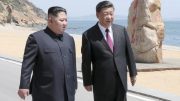China to be be linked to Hong Kong and Macau by bridge
Advertisement – Advertise here from OMR 100 / $275 USD
Al-Sahawat Times | Ethical Global News from Oman and UAE | Donate HERE
Advertisement – Advertise here from OMR 100 / $275 USD
For decades Italy has attempted to connect to Sicily by bridge or tunnel but has failed short at every attempt due to strong Sicilian independence sentiment and local sabotage.
Spain has frequently considered linking itself to North Africa by bridge or tunnel but their plans never reached fruition.
So the baton passes to China to take the reigns and build the world’s longest bridge. The bridge however is not without its political opposition.
This Chinese project is one of the most criticised initiatives in Hong Kong, where the bridge is seen as another way for Beijing to extend its control.
The world’s longest sea bridge is set to open this week, linking Chinese mainland with the island cities of Hong Kong and Macau. This is seen by some activists in Hong Kong as part of a broader contentious plan to integrate the special administrative regions into China.
Hong Kong was invaded by the British and repatriated to China in the 1990s. Since then a small but vocal group of activists have rejected rule by anyone, British or Chinese.
The $20bn USD Hong Kong-Zhuhai-Macau bridge officially opens on Tuesday in a ceremony that Chinese president Xi Jinping is reportedly planning to attend. Officials are billing the 55km bridge as a key part of the Greater Bay Area plan, a campaign to connect Hong Kong and Macau to 11 Chinese cities to form a high-tech region to rival Silicon Valley.
PRESPECTIVE – Famous narrow straights (where bridges were planed)
- Italy to Sicily | 3.1 KM | Failed
- Spain to Africa | 14 KM | Never built
- UK to Europe | 35 KM | Tunneled
- Oman to Iran | 39 KM | Never built
- HKZM Bridge | 55 KM | OpensTuesday
- Sicily to Africa | 155 KM | Tunnel under construction
- Italy to Balkans | 93-225 KM | Never built
The bridge links Hong Kong’s Lantau island to Zhuhai on the southern coast of Guangdong province and the gambling hub of Macau, a popular tourist spot for Chinese visitors.
“The bridge is a mega transport infrastructure jointly built by Guangdong, Hong Kong and Macau. The collaboration between Guangdong, Hong Kong and Macao in terms of trade, finance, logistics and tourism will be strengthened. Hong Kong will assume a more proactive role in the development of the Greater Bay Area.’’ Hong Kong’s secretary for transport and housing, Frank Chan Fan, said on Friday.
However, private cars will only be able to use it after applying for a special permit. The crossing will mostly be used by private shuttle buses and freight vehicles. The bridge will not be served by public transport.
Since its inception, it has been one of the most criticised initiatives in Hong Kong, where residents believe it is a poor use of taxpayer funds. Conservationists have blamed bridge construction for falling numbers of the threatened Chinese white dolphin. Others say the bridge is another way for Beijing to bind the autonomous administrative regions closer to China.
“It is a politically driven mega-project without urgent need,” said pro-democracy lawmaker Eddie Chu. Earlier this year, officials said traffic on the bridge would see about 25% less traffic by 2030 because of another competing bridge. “Basically it is redundant,” he said.
Under construction since 2009, the structure is supported by three cable-stayed bridges and designed to withstand winds of up to 340km an hour. A 6.7km undersea tunnel has been built to avoid disrupting shipping lanes, connected by two artificial islands.
Towers above the bridge are designed to look like dolphins, in honour of the white dolphin, Chinese knots and a boat’s mast, according to the bridge’s designer. The curves of the road are meant to resemble a snake.
Originally slated to open in 2016, the bridge has been dogged by construction delays, budget overruns, and safety issues. Nine workers have died and more than 200 others have been injured building the bridge. This year, six subcontractors have been fined for endangering workers.
Earlier this year, concrete blocks around the artificial island appeared to be floating away, prompting criticism of the quality of the bridge. Officials said the placement was deliberate.
Some say the bridge is not needed, given existing transport links to mainland China. “I don’t think people are too excited about it. It’s been dragged on for so long and it’s so expensive, and there are already means of going to the western side of the Pearl River Delta,” said Mee Kam Ng, a professor at the department of geography at the Chinese University in Hong Kong.
In some ways, the bridge does advance integration of the three cities. Commuters on the bridge will go through three different checkpoints for Hong Kong, Macau, and Zhuhai.
Yet regardless of the arguments against the project by activists, as a feat of engineering brilliance it is undeniable that China is stamping its name on the world again in a grandiose fashion. Whilst Saudi Arabia and Dubai are currently the world’s hubs for record breaking engineering followed by Japan and South Korea, China, once a world renown nation for engineering has once again re-entered the stage of A-Listers.
Since you’re here …
… we have a small favour to ask. More people are reading Al-Sahawat Times than ever but advertising revenues across the global media industry are falling fast. And unlike many news organisations, we haven’t put up a total paywall. We want to keep our journalism as open as we can. So you can see why we need to ask for your help. Al-Sahawat Times’ independent, investigative journalism takes a lot of time, money and hard work to produce. But we do it because we believe truly ethical media and an unbias perspective really matters.
“I appreciate there not being a paywall: it is more democratic for the media to be available for all and not a commodity to be purchased by a few. I’m happy to make a contribution so others with less means still have access to information.”
If everyone who reads our reporting, who likes it, helps fund it, the future of ethical media and the futures of our staff and their families would be much more secure. For as little as £1, you can support Al-Sahawat Times and it only takes a minute. Thank you.
This story is available on:
APPLE NEWS | GOOGLE NEWS | FLIPBOARD | AL-SAHAWAT TIMES
Talk to a journalist
Email: NewsDesk@alsahawat.com
Web: alsahawat.com
Follow Al-Sahawat Times
?Read it on FLIPBOARD
M.AlSaid@alsahawat.com | Journalist
Views: 0







